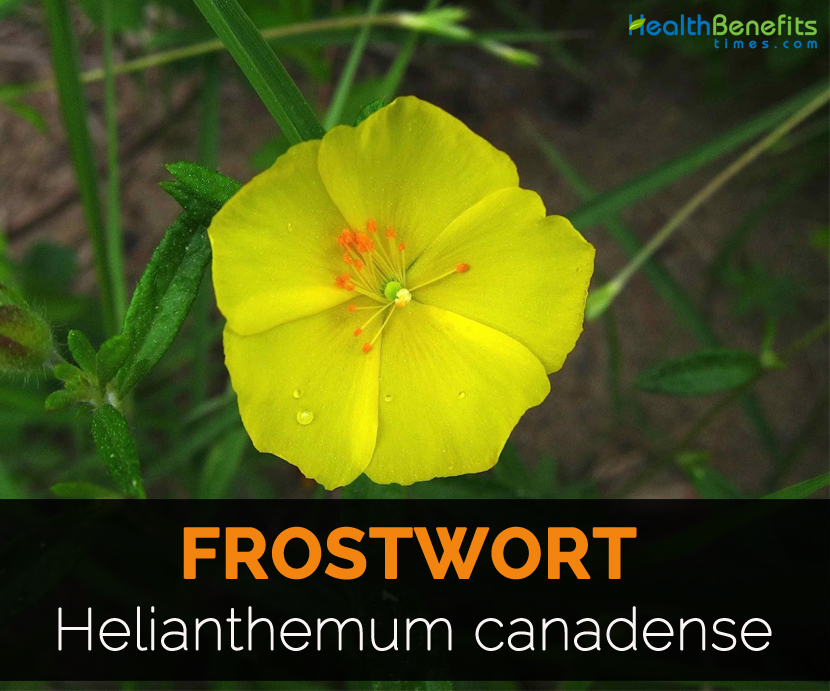| Frostwort Quick Facts | |
|---|---|
| Name: | Frostwort |
| Scientific Name: | Helianthemum canadense |
| Origin | Eastern North America |
The whole plant is official, having slight aromatic odour; and astringent and bitter taste.
Professor Eaton, in his work on Botany, records this curious fact of the plant: “In November and December of 1816, I saw hundreds of these plants sending out broad, thin covered ice crystals, about an inch in breadth from near the roots. These were melted away by day, and renewed every morning for more than twenty-five days in succession.”
Frostwort is a flowering perennial plant 8-24 inches high which blooms from May to June. Normally each stem has single flower but rarely can have two. Flower is yellow with five petals and between ¼ and 1 ¼ inches across. Leaves are covered in hairs and alternate in pattern. Stems are covered in hairs and are brown or green in color.
Facts about Frostwort
| Name | Frostwort |
|---|---|
| Scientific Name | Helianthemum canadense |
| Native | Eastern North America |
| Common/English Name | Rock Rose, Frostweed, Frost Plant, Sun Rose, Scrofula Plant, Longbranch frostweed, Canada frostweed, Rock frost, Frostplant, Frostwort |
| Name in Other Languages | English: Canada frostweed, Longbranch frostweed; French: Hélianthème du Canada |
| Soil | Dry, base-rich |
| Medicinal part | The herb |
| Flowering Season | May until July |
| Flower | Bright yellow, saucer-shaped |
Flower
Flowers are single stalked at the tip of stem or branch, sometimes two but only one flower opens at a time. Flowers are about ¾ to 1¼ inch across with five yellow petals and 10 or more orange tipped stamens fanning around small central column. Flowers are five green to red tinged sepals, inner three broadly triangular, outer two very narrow and half as long to nearly as long as the inner. Sepals are covered in a mix of short star shaped hairs, long and spreading to ascending hairs.
Leaves and stems
Leaves are alternate, narrowly elliptic or wider, 1 ¼ inch to 1/3 inch wide, pointed or blunt at the tip, stalkless and tapering at the base. Upper surface is shiny and covered in short star shaped hairs mixed with scattered, long and unbranched hairs. Typically leaves on branches are smaller than those on main stem and do not have long and unbranched hairs. The undersides of leaves are densely covered in short and star shaped hairs providing gray-green appearance. Stems are hairy, round, green or brown, initially branched forming several ascending branches after initial yellow petaled flower has finished blooming.
Fruit
A round capsule which is enclosed by persistent sepals resembling cleistogamous flowers. Usually, the fruits developed from yellow petaled flowers are larger and has more seeds than fruit developed from cleistogamous flowers.
Medicinal uses
- Dried leaves act as antiscrofulatic, laterative, tonic and astringent.
- Tea made from leaves is used for treating kidney ailments and sore throats.
- Strong leaf tea is used for treating scrofula.
- Apply it externally to eye infections and skin diseases.
- Use it in the form of syrup, decoction and fluid extract.
Uses
Has been used for cancerous degenerations, especially the oil procured from the plant. In scrofula, its valuable contents have performed with astonishing admiration.
It can be used with advantage in diarrhoea, as a gargle in scarlatina and aphthous ulcers (small white ulcers on the tongue, and in the mouth) and as a wash in scrofulous ophthalmia. Effective in venereal treatment, obviating the many side-effects of the popular treatment.
It is used in the form of decoction, syrup, or fluid extract, but is advised to be used with Dicentra canadensis (Corydalis) and Stillingia.
Dose
Steep 1 teaspoonful of the granulated herb in 1 cup of boiling water for ½ hr., strain, take 1 tablespoonful three to six times a day. Of the tincture, 5–10 min.
Externally
- The leaves made into a poultice are effective in treating scrofulous tumours, and ulcers.
- Surely there is something in the unruffled calm of nature that exceeds our anxieties and doubts, and is in control by obeying her.
Precautions
Overdose causes nausea and vomiting.
References:
https://www.itis.gov/servlet/SingleRpt/SingleRpt?search_topic=TSN&search_value=22258#null
https://en.wikipedia.org/wiki/Helianthemum_canadense
https://pfaf.org/user/Plant.aspx?LatinName=Helianthemum+canadense
http://temperate.theferns.info/plant/Helianthemum+canadense
https://www.minnesotawildflowers.info/flower/canada-frostweed
https://en.wikipedia.org/wiki/Helianthemum
https://practicalplants.org/wiki/Helianthemum_canadense
https://en.wikipedia.org/wiki/Helianthemum_nummularium
https://www.henriettes-herb.com/eclectic/king1854/helianthemum.html
https://practicalplants.org/wiki/Helianthemum_canadense
Comments
comments
